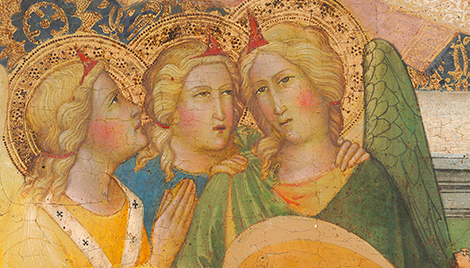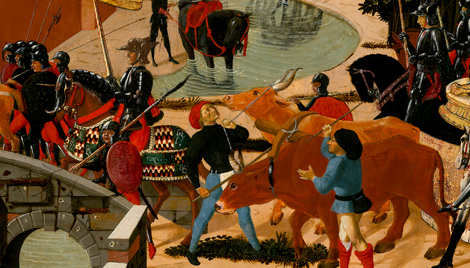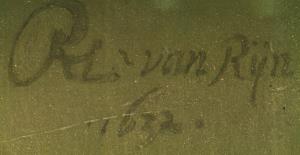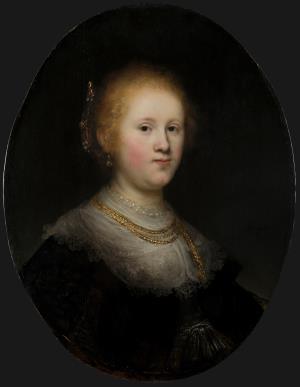Portrait of a Young Woman
Portrait of a Young Woman
- Artist
- Rembrandt van Rijn
- Artist Dates
- 1606 - 1669
- Artist Nationality
- Dutch
- Title
- Portrait of a Young Woman
- Date
- 1632
- Medium
- oil on panel
- Dimensions
- 63.9 x 49.3 cm (25-1/8 x 19-3/8 in)
- K Number
- K39
- Repository
- Allentown Art Museum
- Accession Number
- 1961.035.000
- Notes
Provenance
Louis, Duc d’ Orléans [1703- 1752], Paris, France in 1727; by inheritance to Louis-Philippe, Duc d' Orléans [1725-1785] Paris, France; by inheritance to Louis-Philippe-Joseph, Duc d' Orléans [1747-1793], Paris, France; (Orléans Collection Sale, London [private contract sale], in 1793); Thomas Moore Slade, buying for George Kinnaird 7th Baron Kinnaird [d. 1805]. William Morland. Thomas Hammersley, London. Charles Birch or Cox. London, England; [1] George O'Brien Wyndham, 3rd Earl Egremont [d.1837] London and Petworth House, Sussex; by inheritance in to George Wyndham 1st Baron Leconfield [1787-1869], Petworth; by inheritance to Henry Wyndham 2nd Baron Leconfield [1801-1901], Petworth; by inheritance to Charles Henry Wyndham 3rd Baron Leconfield [1852-1952], Petworth; sold 1927 to (P. & D. Colnaghi, London); sold to (Count Alessandro Contini Bonacossi [1878-1955], Florence-Rome) in 1928; sold to Samuel H. Kress [1863-1955] on 2 October 1928 as Rembrandt; gift to the Allentown Art Museum in 1961, no. 1961.35. [1] Either Birch sold painting to Egremont on 27 January 1800, or Cox sold it to Egremont c. 1801 - 1803.
Catalogue Entry
Rembrandt van Rijn
Portrait of a Young Woman
K39
Allentown, Pa., Allentown Art Museum (61.35.G), since 1960. Oil on oval oak panel.(1) 25 1/8 x 19 3/8 in. (63.9 x 49.3 cm.). Inscribed at lower right: RHL [the artist's monogram] van Rijn 1632.(2) Restored by de Wild in 1927 (in The Hague, for Colnaghi). Restored and European cradling replaced with a more extensive one by Pichetto in 1930. Varnished by Modestini in 1960.(3) Allentown, 1960, p. 116. A young woman with thin curly blonde hair is shown to the waist, in three-quarter view against a neutral background. She wears a white gauze collar over a lace one and a dark dress with a gold brocade insert below the bosom. Her jewels include pearl earrings and a jeweled ornament (cap?) at the back of her head; a double strand pearl choker and three gold and amber chains are around her neck. For two centuries, K39 was kept together with a Rembrandt oval Self-Portrait of the same date and size; it has often been assumed that the paintings were planned as pendants.(4) This seems unlikely in view of the fact that the poses are not complementary. Rembrandt painted many portraits of young women who resemble the Kress sitter; their identity remains in dispute. Unless otherwise indicated, all of the following sources accepted K39 as an autograph work by Rembrandt. K39 was first recorded in the 1727 Orléans catalogue (see Provenance) as the portrait of a Flemish woman by 'Paul Rembran' [sic]. The Orleans catalogue of 1786-1808 noted that some connoisseurs thought that the Kress panel and a male portrait by Rembrandt of the same size and date (also in the Orléans collection) represented Rembrandt and his wife.(5) Smith included K39 in his catalogue raisonné of Rembrandt's works.(6) When Waagen saw the panel at Petworm he noted that it was 'hung too high to permit of an opinion, though at that distance giving the impression of being a Ferdinand Bol'.(7) Bode was the first to identify the subject of the Kress panel as Rembrandt's sister.(8) Dutuit followed Bode's views.(9) Wurzbach listed K39 as a 'portrait of the artist's sister(?)'.(10) It is described by Michel as an undated portrait of Rembrandt's sister.(11) Moes also considered the portrait to be of Rembrandt's sister Lisbeth.(12) The panel was dated c. 1632 by Valentiner who listed it as 'so-called Rembrandt's sister'.(13) Hofstede de Groot dated the Kress oval c. 1631, entitling it Liesbeth van Rijn.(14) Meldrum viewed the subject as Rembrandt's sister.(15) The identification of the portrait as Rembrandt's sister was queried by Valentiner, who noted that the same model was painted at least twelve times during the young painter's first two years in Amsterdam. Lisbeth is not known to have accompanied the artist to that city and is only recorded as residing in Leyden. Valentiner, noting that there are two examples of the same sitter painted as a companion piece to the artist's self-portrait, proposed that she represents the artist's first love, who after mid-1633 was replaced by Saskia, whom she resembled very considerably.(16) The portrait was characterized as 'nothing if not sturdily conventional in conception and execution' by Frankfurter.(17) Bredius believed it to represent Rembrandt's sister.(18) In 1951 the painting was described as showing ' ... the masterly pictorial qualities, fine brushwork, and luminosity for which Rembrandt was famed'.(19) Shapley (Allentown, 1960, p. 116) noted that 'The contented expression of the young woman in our portrait, the golden glow of her brightly lighted head, and the richness of her parure of gold, pearls and amber are an appropriate index to the brilliant period upon which Rembrandt's career was entering when he painted this picture. The style is meticulous and detailed in comparison with that of his late work; it is the style in which he painted the first of his great figure groups, The Anatomy Lesson, which also dates from 1632.' Bauch believed the subject to be Saskia van Uylenborch, whom Rembrandt married in 1634. The young painter is known to have lived in the house of Saskia's relative Hendrick Uylenborch between 1632 and 1635.(20) In 1968, Gerson called the panel Young Woman with a Golden Necklace.(21) In his revision of Bredius, Gerson used the traditional title, 'Rembrandt's sister', for K39 and many other portraits of the same model from the 1630s but implied that this is not a satisfactory identification.(22) He further noted that he had not seen it. After examining the painting late in 1969, however, Gerson stated that he no longer accepted it as an autograph work.(23) The portrait is rather thinly painted, lacking the carefully built up form so characteristic of Rembrandt's technique. Burroughs commented on the dissimilarity between K39 and the canonical works, as revealed by X-rays. His observation concerning this disparity is correct.(24) The painting may well be the work of a studio associate. The young Rembrandt is known to have had an informal academy from his early Amsterdam years onwards; one of the participants may have executed the bulk of the panel. This romantic, picturesque garb was often worn by Rembrandt's models in the 1630s. The signature on K39, however, is entirely consistent with Rembrandt's, probably added by the master himself in accord with his practice of working over and signing his students' works.(25) Provenance: Duc d'Orléans, Regent, Paris, Palais Royal, by 1727.(26) Sold by Duc d'Orléans (Philippe Egalité) in 1792, to Thomas More Slade,(27) exhibited –London, The Orléans Gallery now exhibiting at the Great Room of the Royal Academy, Apr. 1793, Cat. No. 68, organized by Mr. Wilson. Purchased by 3rd Earl Egremont, Petworth, from Charles Birch, 27 Jan. 1800, together with the pendant, Self Portrait of Rembrandt.(28) 1st Baron Leconfield, 1837, heir to the Earl of Egremont, Petworth. 2nd Lord Leconfield, exhibited –London, Royal Academy, Winter Exhibition, 1899, Works by Rembrandt, p. 17, Cat. No. 39, as 'Portrait of the Painter's Sister'.(29) Sold 1927 by Leconfield, probably to Colnaghi, London. Rome, A. Contini-Bonacossi. Kress acquisition 1928, exhibited –Detroit, Institute of Arts, The Thirteenth Loan Exhibition of Old Masters, Paintings by Rembrandt, 2-31 May 1930, Cat. No. 13. New York, M. Knoedler and Co., Loan Exhibition of Paintings by Rembrandt, 17-29 Apr. 1933, Cat. No. 2 as 'Portrait of Rembrandt's Sister Lisbeth'. Indianapolis, Ind., The John Herron Art Institute, Dutch Paintings, Etchings, Drawings, Deftware of the Seventeenth Century, 27 Feb.-11 Apr. 1937, Cat. No. 58. New York, World's Fair, European and American Paintings 1500-1900, Masterpieces of Art, May-Oct. 1940, p. 64, Cat. No. 85, as 'Portrait of a Girl, thought to be Rembrandt's sister.' New York, Duveen Brothers, Paintings by the Great Dutch Masters of the Seventeenth Century, 8 Oct.-7 Nov. 1942, p. 60, Cat. No. 40, as 'Portrait of Rembrandt's Sister'. New York, Wildenstein and Co., A Loan Exhibition of Rembrandt, 19 Jan.-25 Feb. 1950, p. 17, Cat. No.6, as 'A Girl, supposedly Rembrandt's sister'. Tucson, The University of Arizona, Twenty-five Paintings from the Collection of the Samuel H. Kress Foundation, 1951, Cat. No. 16. Washington, D.C., the National Gallery of Art, Exhibition of Art Treasures for America from the Samuel H. Kress Collection, 10 Dec. 1961 -4 Feb. 1962, Cat. No. 76.
References
(1) Erroneously described as on canvas by Kurt Bauch, Rembrandt, Gemälde, Berlin, 1966, p. 24, Cat. No. 453. (2) The final two digits were not legible in 1899 when K39 was exhibited at the Royal Academy. (3) According to Alan Burroughs (Kress Archive, c. 1935), the painting is in perfect condition. He observed that 'there is no indication of modeling [for] any but the surface pose. The lack of anatomical forms in the head is obvious in the spotty and erratic modeling of the cheeks and chin ... it is possible to show by comparison with many shadowgraphs of indubitable Rembrandts that this is not Rembrandt's technique, nor does it approach him in mastery of anatomical knowledge. The numerous portraits of this same model, unequal in aesthetic value and treatment, indicate that Rembrandt used her in his school or set up his own portraits of her for pupils to interpret in their own way.' (4) Supports of this format and size were frequently used by Rembrandt in the 1630s. (5) J. Couché, Galerie du Palais Royal gravée d'après les tableaux des différentes écoles qui la composent, avec un abrégé de 1a vie des peintres et une description historique de chaque tableau, Paris, 1786-1808, 1808, n.p. A print by Ingouf le Jeune after K39 is published by Couche, giving the painting as part of the Orléans collection at Riney (near Paris) though it was no longer there by 1808. K39 and the 'Self-Portrait' were listed as 'Flamand et Flamande', the first and second paintings by Rembrandt (of six) in the Orléans collection. Both oval paintings were reproduced in Gobelin tapestry (signed 'Cozette' and dated 1779) while in the Orléans collection. Both the tapestries were probably acquired at the same time as the paintings for Petworth (see Provenance). The tapestries are now owned by Mayorcas (London, reproduced in Connoisseur, CLXXlII, 1970, p. 262). (6) John Smith, A Catalogue Raisonné of the Works of the Most Eminent Dutch, Flemish and French Painters, VII, London, 1836, p. 168, Cat. No. 524, listed as 'A Lady'. (7) Gustav Friedrich Waagen, Treasures of Art in Great Britain, III, London, 1854, p. 41, as 'a female portrait'. (8) Wilhelm Bode, Studien zur Geschichte der holländischen Malerei, Brunswick, 1883, pp. 421, 591. Also Bode and C. Hofstede de Groot, Rembrandt, beschreibendes Verzeichniss seiner Gemälde, Paris, 1897, I, p. 152. (9) Eugène Dutuit, Tableaux et Dessins de Rembrandt, Paris, 1885, p. 61, Cat. No. 187. The portrait is mistakenly described as in profile, with a large hat. Also mentioned by Dutuit in Rembralldt, L'Oeuvre du MaItre, Paris, n.d., p. 59. (10) Alfred von Wurzbach, Rembrandt Galerie, Stuttgart, 1886, p. 64, Cat. No. 216. (11) Emile Michel, Rembrandt, his Life, his Work and his Time, New York, 1894, II, p. 236. (12) E. W. Moes, Iconographia Batava, Amsterdam, 1905, II, p. 308, no. 4. (13) Wilhelm R. Valentiner, Rembrandt, Klassiker der Kunst, Stuttgart and Berlin, 1908, pl. 59 and p. 551. (14) C. Hofstede de Groot, A Catalogue Raisonné of the Works of the Most Eminent Dutch Painters of the Seventeenth Century, VI, London, 1916, p. 331, no. 696. (15) D. S. Meldrum, Rembrandt's Paintings, New York, n.d. [after 1922], p. 187. (16) W. Valentiner, The Thirteenth Loan Exhibition oj Old Masters, Paintings by Rembrandt, Detroit Institute of Art, 1930, pp. 8-9, Cat. No. 13. In his Rembrandt Paintings in America, New York, 1931, n.p., Cat. No. 19, Valentiner again noted that the identification of the sitter as Rembrandt's sister was not well-founded. (17) Alfred M. Frankfurter, 'New York's First Rembrandt Exhibition', Fine Arts, May 1933, p. 8. (18) Abraham Bredius, The Paintings of Rembrandt, Vienna, 1936, p. 5, Cat. No. 86. Also London, 1942, I, p. 6, Cat. No. 86. (19) Twenty-five Paintings from the Collection of the Samllel H. Kress Foundation, The University of Arizona, 1951, Cat. No. 16. (20) Kurt Bauch, Der frühe Rembrandt und seine Zeit, Berlin, 1960, p. 261. He cited the archival discoveries of H. F. Wijnmann, Jaarboek Amstelodamium, XLIII, 1956, pp. 94 ff. In 1966 (op. cit., p. 24, Cat. No. 453), Bauch listed K39 as Saskia with a Golden Chain. (21) Horst Gerson, The Paintings of Rembrandt, New York, 1968, p. 262, no. 116. (22) Gerson, Rembrandt, The Complete Edition of the Paintings (Bredius), revised by Horst Gersoll, New York and London, 1969, p. 76 (plate), Bredius 86, n. 86, p. 554. (23) Letter of 11/XI/69, Kress Archive. (24) See supra, Note 3. (25) See Joachim von Sandrart, Academie der Bau-, Bild-, und Mahlerey-Künste von 1675, ed. by A. R. Peltzer, Munich, 1925, pp. 202-3. Georges Isarlo, 'Rembrandt et son Entourage', Renaissance, Sept. 1936, pp. 1-50. Egbert Haverkamp-Begemann, Introductory 'Rembrandt as Teacher', in Rembrandt after Three Hundred Years, Chicago, 1969, pp. 21-9. A chapter on Rembrandt students is provided by Gerson, 1968, op. cit. Note 21 above, pp. 146 ff. (26) Louis Francois Dubois de Saint-Gelais, Description des Tableaux du Palais Royal, Paris, 1727, pp. 364-5 as: Le Portrait d'une flamande. oval. 2 pieds x 1 pied 6 pouces by Paul Rembran. Elle est cöefée en chevellx plats, & a un colier de perles avec boucles d' oreilles de meme & un colet qui monte fort haut, comme le portoient autrefois les femmes, & par dessus un autre colier qui est d'ambre, faisant plusieurs tours, & dont le bout tombe sur le devant de son corps. The pendant is mentioned and described on p. 365 as a 'Flamand'. In 1752 (Inventory II, after the Regent's death), K39 was valued at 300 Livres. In Inventory III, after the death of the Regent's grandson, it was valued at 500 Livres. Both inventories are Paris, Archives Nationales. According to Casimir Strjienski, La Galerie du Regent Philippe, duc d'Orléans, Paris, 1913, pp. 108, 182, Cat. No. 396, K39 (as 'Rembrandt's Sister') was listed in the second inventory at 320 Livres. (27) For Slade's purchase of the Flemish, Dutch, and German paintings in the Orléans collection in 1792, see William Buchanan, Memoirs of Painting, London, 1824, I, pp. 17-18. K39 is listed by Buchanan (p. 196, no. 2) as Portrait of a Fleming's Wife, valued at 150 guineas. The Kress panel was not in the Jullienne sale of 1767 (Paris, p. 53, Cat. No. 131) as suggested by Dutuit, Tableaux et Dessins de Rembrandt, Paris, 1885, p. 46. Nor was it in the A. Roehn sale (Paris, 1868) as also noted by Dutuit. (28) Royal Academy of Arts, London, 1962, Primitives to Picasso, p. 46 (entry for Cat. No. 124 –the Rembrandt Self-Portrait). According to a memorandum from P. and D. Colnaghi of 1931 (London), K39 was sold by Mr. Cox, another agent of the Duc d'Orléans, to Lord Egremont, c. 1801-3. (29) See also C. H. Collins Baker, Catalogue of the Petworth Collection of Pictures in the Possession of Lord Leconfield, London, 1920, p. 101, Cat. No. 170, as Lisbeth van Rijn.












